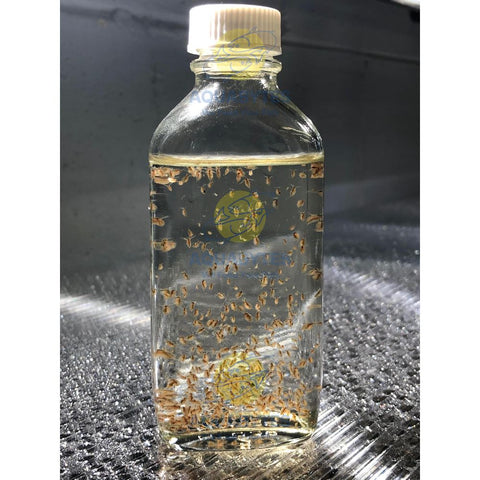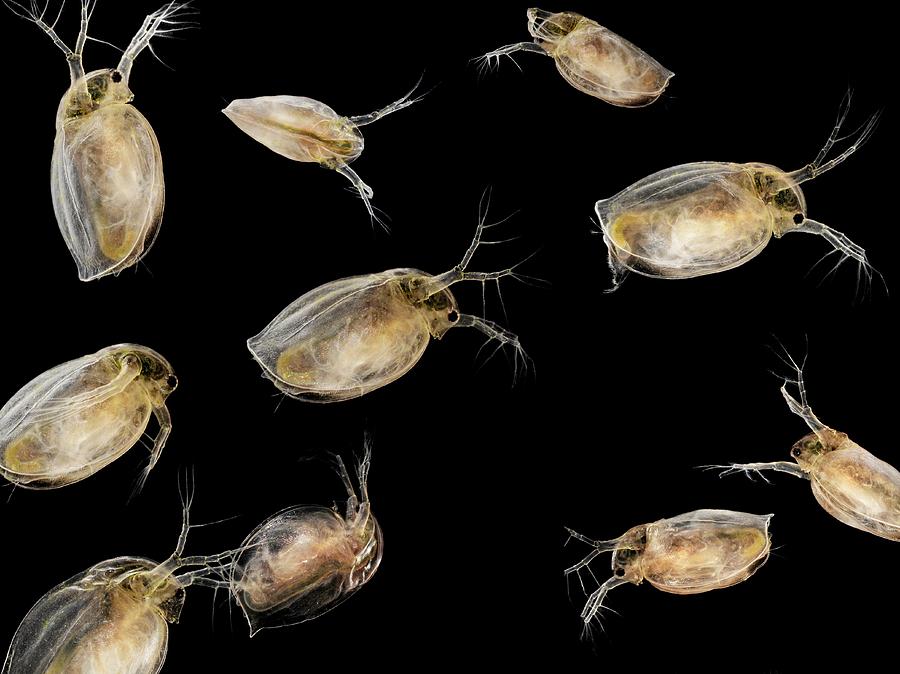Daphnia magna, also known as the water flea, is a species of small, freshwater crustaceans that belongs to the family Daphniidae. They are commonly used as model organisms in research, particularly in the fields of ecology, toxicology, and genetics. Daphnia magna are important members of freshwater ecosystems, serving as a food source for fish and other aquatic animals.
Identification:
Daphnia magna are small, typically measuring between 0.5 and 5 mm in length. They have a transparent body and a single, large compound eye. They have two pairs of antennae on their head and five pairs of legs. The legs are fringed with small, hair-like structures called setae, which are used for swimming and feeding.
Habitat:
Daphnia magna are found in a wide range of freshwater habitats, including lakes, ponds, rivers, and streams. They are particularly abundant in eutrophic (nutrient-rich) waters, where they feed on algae and other small organisms. Daphnia magna are sensitive to changes in water quality and are often used as bioindicators of pollution or other environmental stressors.
Behavior:
Daphnia magna are filter feeders, using their setae to capture small particles and organisms in the water. They are also capable of asexual reproduction, with females producing offspring that are clones of themselves. Daphnia magna are also capable of sexual reproduction, with males transferring sperm to females during mating.
Importance:
Daphnia magna are important members of freshwater ecosystems, serving as a critical link between primary producers (such as algae) and higher trophic levels (such as fish and other predators). They are also commonly used as model organisms in research, particularly in the fields of ecology, toxicology, and genetics. Because of their sensitivity to environmental stressors, Daphnia magna are also used as bioindicators of pollution or other environmental changes.

Requirements for Culturing:
- Daphnia Magna ✅CLICK HERE TO BUY NOW ✅
- Distilled Water or Dechlorinated Tap Water
- Green Water or Alternative Food Sources
- Container that can hold water
- Alkaline PH buffer or Baking Soda
- Artificial Light Source (E.g LED lighting)
Step by Step Guide:
- Use a clean container with a preferably large surface area. A standard 20L bucket will suffice.
- Fill the volume of the container with distilled water or dechlorinated tap water before adding the live daphnia culture. Daphnia will not tolerate chlorine. The Daphnia will usually die if you add tap water directly into your container when making water changes.
- Check the pH of the water, as it should exceed PH 7, this is because daphnia reproduce quickly and use up calcium and minerals in the water to build their exoskeletons. If PH falls short, add alkaline PH buffer or baking soda until greater than PH 7 is reached.
- Position the container near the light source. Daphnia typically reproduce well with 12 hours of light and 12 hours of darkness a day. Be sure that any artificial light does not significantly heat the water in the container.
- Add a very small portion of green water or an alternative supplement until the water in the container is slightly cloudy. We recommend AQUABYTES- INSTANT Greenwater as it removes the hassle of culturing your own greenwater and it is fortified with other vitamins and minerals to promote growth.
- Repeat feeding after water clears up. This will depend on the density of your culture. The more dense, the more frequent the feeding.

Tips
- Change 20% of the water at least weekly; keep an eye on the ammonia levels. Remember to use dechlorinated or aged or bottled water as your replacement water. You can even use your old aquarium water, when you do a water change, as replacement water. If your daphnia culture is not reproducing quickly and thriving, you might want to do more frequent water changes.
- The daphnia culture doesn't need much oxygen to thrive. Containers kept outside with a large surface area don't need any aeration at all. Containers kept inside should have very light aeration (just enough to break the water surface). Too much aeration (bubbles) can kill off your culture
- It's important to harvest your daphnia on a regular basis. Failure to do so can cause the culture to crash due to overcrowding and lack of food and oxygen.

